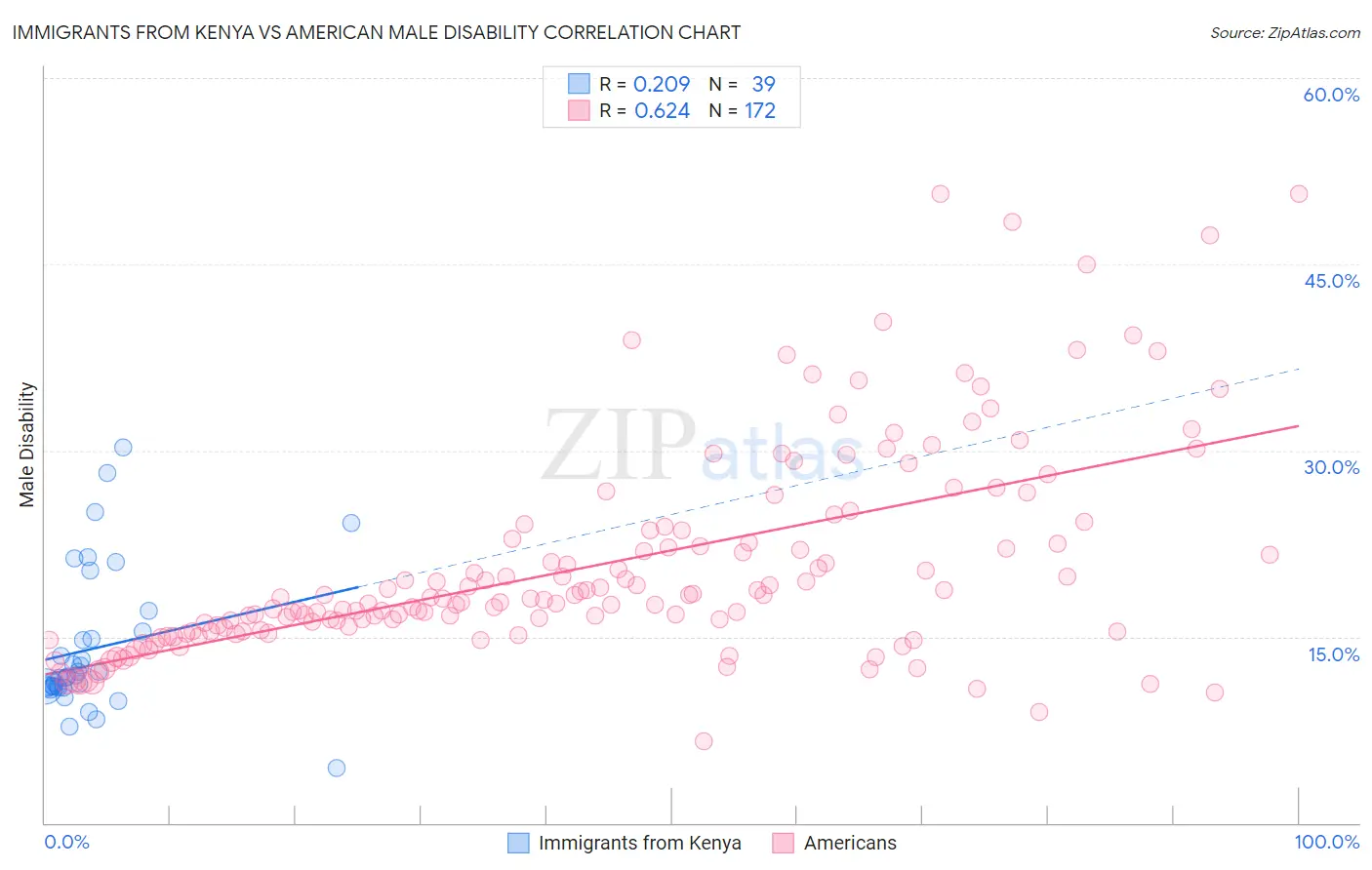Immigrants from Kenya vs American Male Disability
COMPARE
Immigrants from Kenya
American
Male Disability
Male Disability Comparison
Immigrants from Kenya
Americans
11.1%
MALE DISABILITY
63.8/ 100
METRIC RATING
163rd/ 347
METRIC RANK
13.8%
MALE DISABILITY
0.0/ 100
METRIC RATING
319th/ 347
METRIC RANK
Immigrants from Kenya vs American Male Disability Correlation Chart
The statistical analysis conducted on geographies consisting of 218,057,071 people shows a weak positive correlation between the proportion of Immigrants from Kenya and percentage of males with a disability in the United States with a correlation coefficient (R) of 0.209 and weighted average of 11.1%. Similarly, the statistical analysis conducted on geographies consisting of 581,581,297 people shows a significant positive correlation between the proportion of Americans and percentage of males with a disability in the United States with a correlation coefficient (R) of 0.624 and weighted average of 13.8%, a difference of 23.7%.

Male Disability Correlation Summary
| Measurement | Immigrants from Kenya | American |
| Minimum | 4.4% | 6.6% |
| Maximum | 30.3% | 50.7% |
| Range | 25.8% | 44.1% |
| Mean | 14.0% | 20.7% |
| Median | 11.8% | 18.0% |
| Interquartile 25% (IQ1) | 11.0% | 15.4% |
| Interquartile 75% (IQ3) | 15.4% | 23.2% |
| Interquartile Range (IQR) | 4.4% | 7.8% |
| Standard Deviation (Sample) | 5.7% | 8.4% |
| Standard Deviation (Population) | 5.7% | 8.4% |
Similar Demographics by Male Disability
Demographics Similar to Immigrants from Kenya by Male Disability
In terms of male disability, the demographic groups most similar to Immigrants from Kenya are British West Indian (11.1%, a difference of 0.060%), Immigrants from Haiti (11.1%, a difference of 0.090%), Luxembourger (11.1%, a difference of 0.11%), Immigrants from West Indies (11.1%, a difference of 0.12%), and Immigrants from Hungary (11.1%, a difference of 0.15%).
| Demographics | Rating | Rank | Male Disability |
| Russians | 69.8 /100 | #156 | Good 11.1% |
| Immigrants | Western Africa | 69.2 /100 | #157 | Good 11.1% |
| Latvians | 68.1 /100 | #158 | Good 11.1% |
| Guatemalans | 67.2 /100 | #159 | Good 11.1% |
| Albanians | 66.5 /100 | #160 | Good 11.1% |
| Immigrants | West Indies | 65.7 /100 | #161 | Good 11.1% |
| Immigrants | Haiti | 65.3 /100 | #162 | Good 11.1% |
| Immigrants | Kenya | 63.8 /100 | #163 | Good 11.1% |
| British West Indians | 62.8 /100 | #164 | Good 11.1% |
| Luxembourgers | 61.9 /100 | #165 | Good 11.1% |
| Immigrants | Hungary | 61.2 /100 | #166 | Good 11.1% |
| Immigrants | Southern Europe | 54.4 /100 | #167 | Average 11.2% |
| Immigrants | Latin America | 54.0 /100 | #168 | Average 11.2% |
| Barbadians | 53.4 /100 | #169 | Average 11.2% |
| New Zealanders | 52.9 /100 | #170 | Average 11.2% |
Demographics Similar to Americans by Male Disability
In terms of male disability, the demographic groups most similar to Americans are Cree (13.7%, a difference of 0.41%), Tlingit-Haida (13.8%, a difference of 0.49%), Shoshone (13.8%, a difference of 0.54%), Paiute (13.7%, a difference of 0.62%), and Alaska Native (13.6%, a difference of 1.4%).
| Demographics | Rating | Rank | Male Disability |
| Yakama | 0.0 /100 | #312 | Tragic 13.5% |
| Puget Sound Salish | 0.0 /100 | #313 | Tragic 13.5% |
| Aleuts | 0.0 /100 | #314 | Tragic 13.5% |
| Iroquois | 0.0 /100 | #315 | Tragic 13.6% |
| Alaska Natives | 0.0 /100 | #316 | Tragic 13.6% |
| Paiute | 0.0 /100 | #317 | Tragic 13.7% |
| Cree | 0.0 /100 | #318 | Tragic 13.7% |
| Americans | 0.0 /100 | #319 | Tragic 13.8% |
| Tlingit-Haida | 0.0 /100 | #320 | Tragic 13.8% |
| Shoshone | 0.0 /100 | #321 | Tragic 13.8% |
| Apache | 0.0 /100 | #322 | Tragic 14.0% |
| Osage | 0.0 /100 | #323 | Tragic 14.0% |
| Comanche | 0.0 /100 | #324 | Tragic 14.1% |
| Ottawa | 0.0 /100 | #325 | Tragic 14.1% |
| Natives/Alaskans | 0.0 /100 | #326 | Tragic 14.2% |